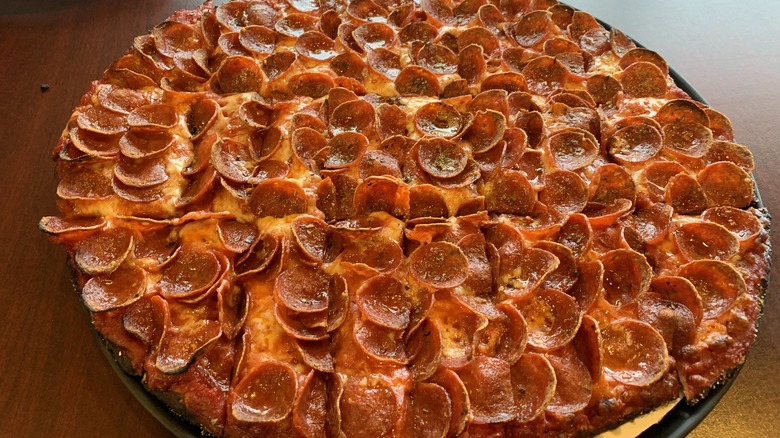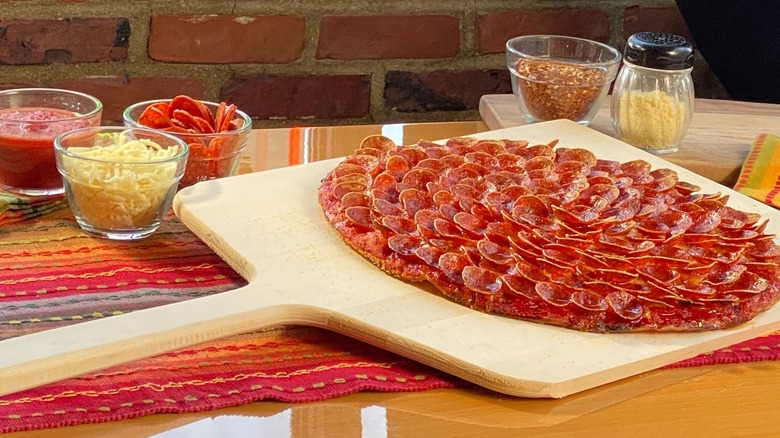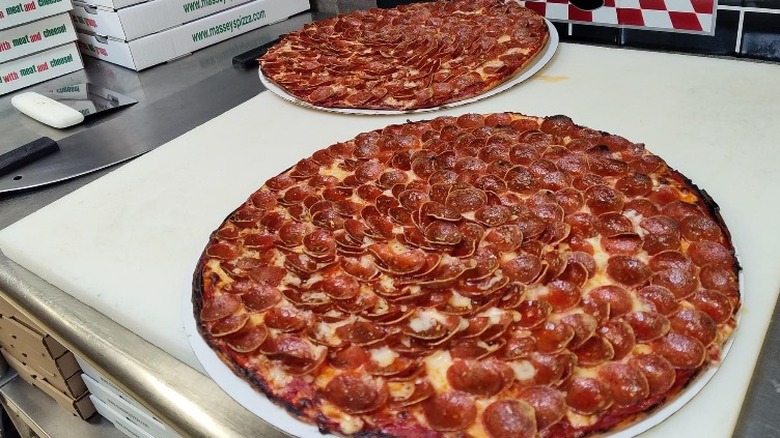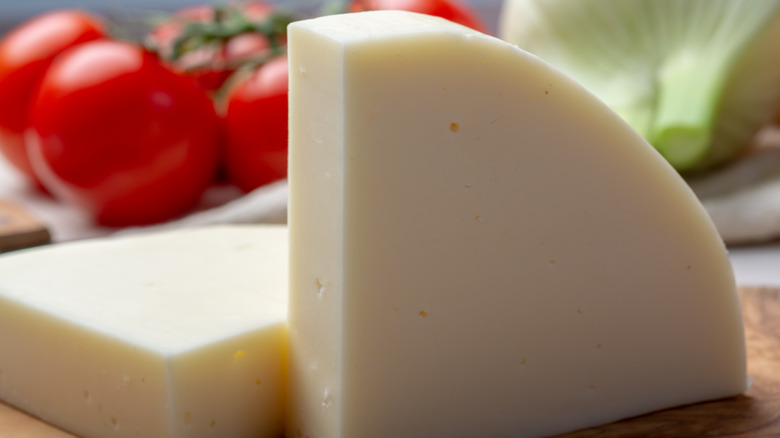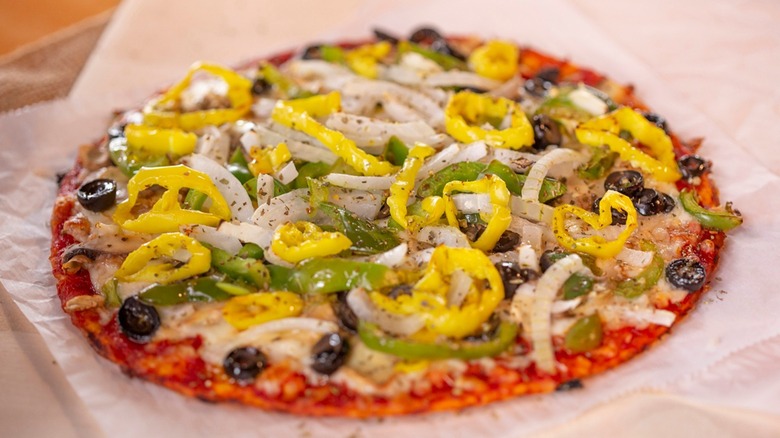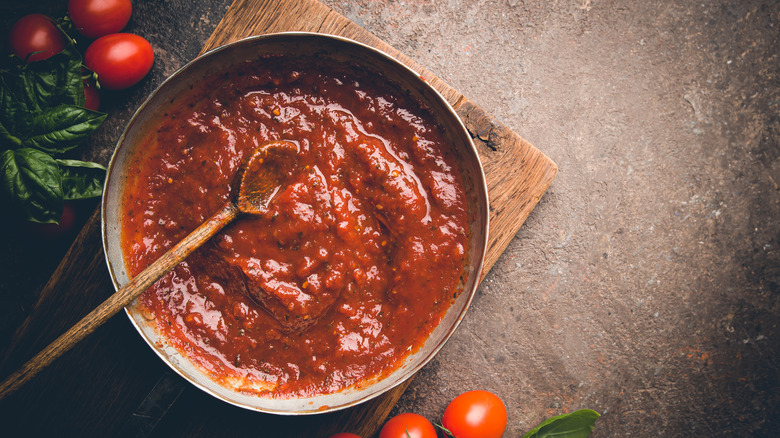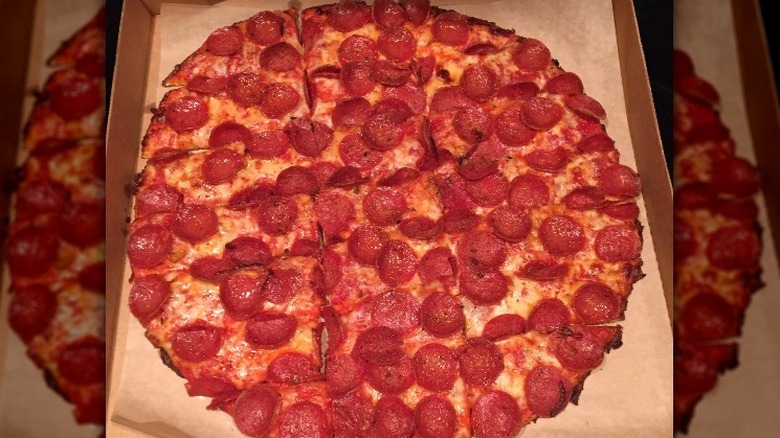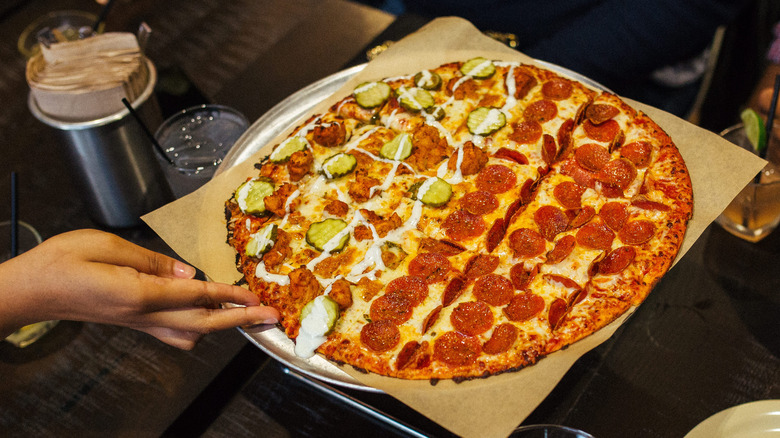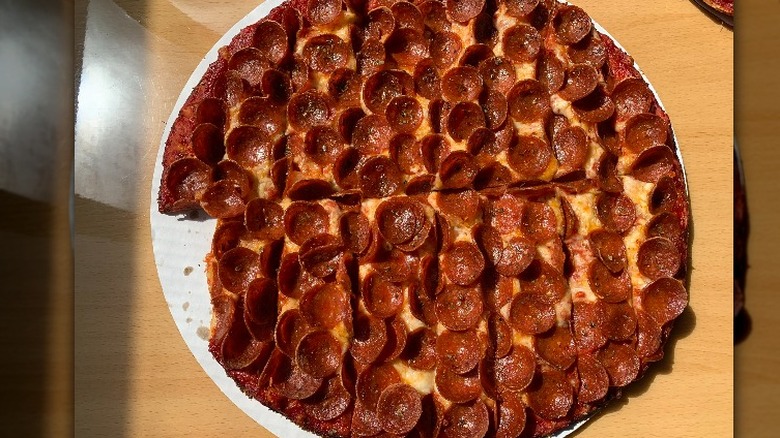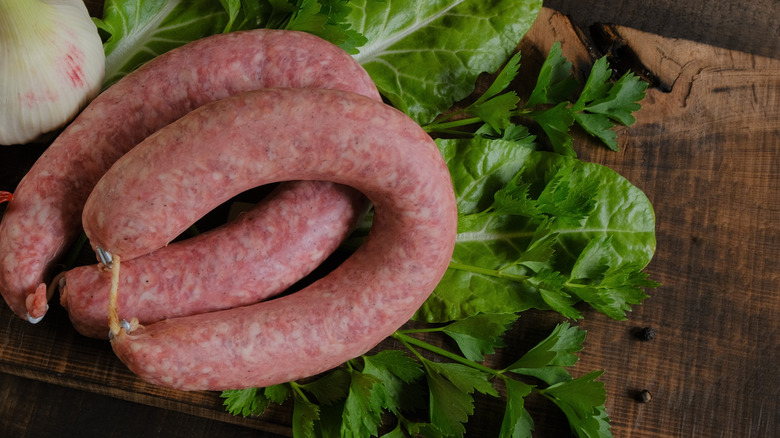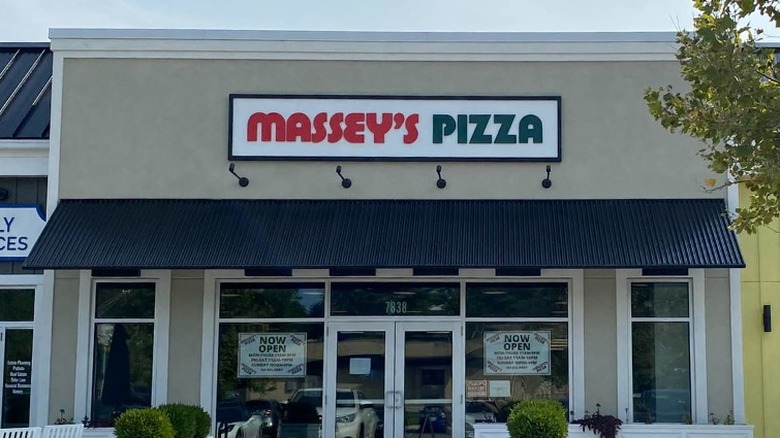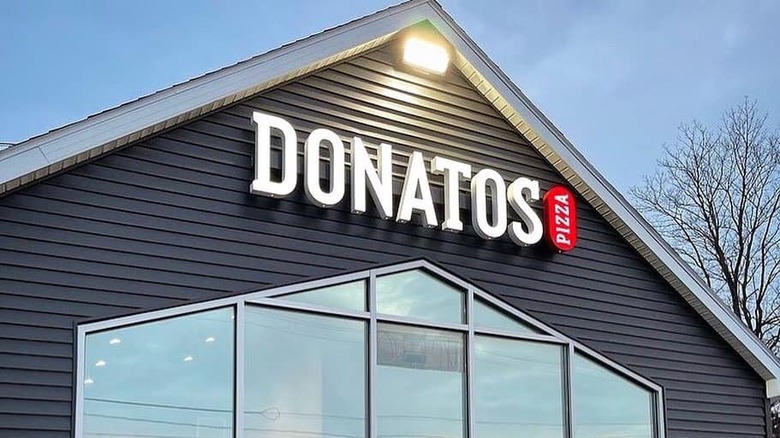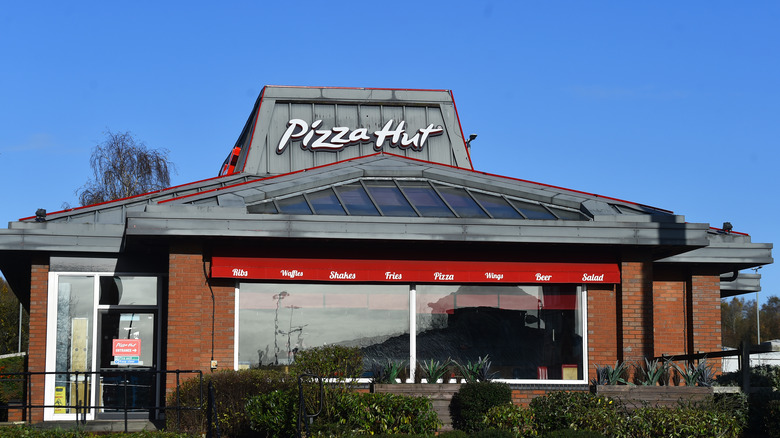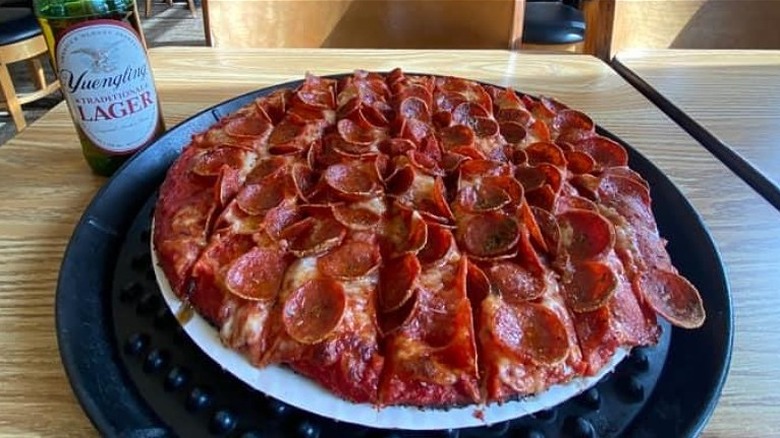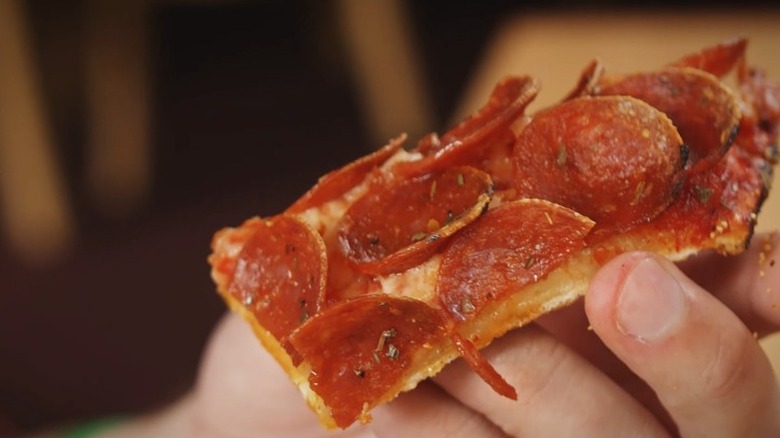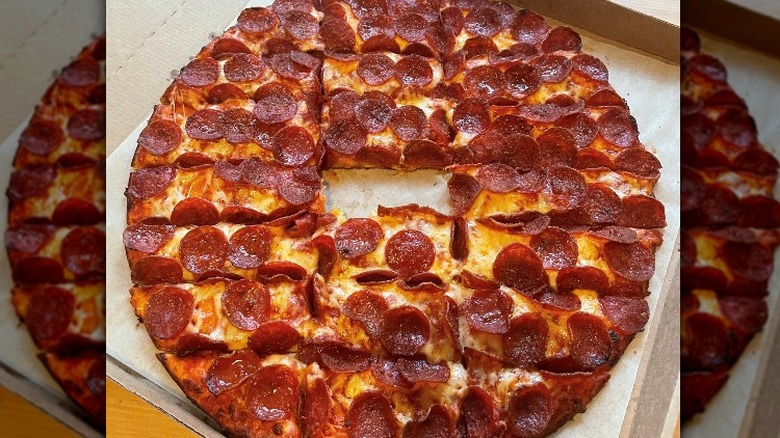Everything You Need To Know About Columbus-Style Pizza
America is nothing if not a nation of regional identities. And while we express these differences through everything from sports to accents to how we refer to soda as pop, obviously, the most important is our regional pizza styles. We all know the thin crust, foldable slices they have in New York pizza shops; the bready, tomato-topped casseroles of Chicago deep dish; and even the coal-fired crispy slices of Connecticut's unique pizza style. But did you know there's a city in Ohio with another regional fashion, one that inspires fierce pride and loyalty usually reserved for the football team?
We're talking about Columbus-style pizza, which shares a hometown with The Ohio State University but still remains relatively unknown. Even those who've visited America's 14th largest city may not have heard of it, as the thin-crust, square-cut pies have yet to catch on nationally. So we chatted with Jim Ellison, who literally wrote the book on Columbus-style pizza, to find out why it's so special. Here's the deal behind the style and where you might be able to find it nearby.
Columbus-style pizza has been around since 1950
Though it's relatively new (or even unknown) on the national regional pizza-style scene, Columbus-style pizza has been around for a long time. According to Jim Ellison, author of "Columbus Pizza: A Slice of History," pizza has been around in Columbus, Ohio, in one form or another since 1934 when TAT Ristorante de Famiglia opened its doors. It was the first restaurant in Columbus to offer pizza, but that style was more traditionally Italian than the Columbus-style known today.
In 1950, a baker named Jimmy Massucci, or Massey for short, teamed up with his good friend Romeo Sirij to open Romeo's Pizza at North Star and Fifth Avenue in Columbus, according to a story in the Columbus Dispatch. Massey — as the pizza's square cut is now called — was the first to use pepperoni on a pizza as well. The style that the two created at the original shop, Romeo, would eventually become what we know today as Columbus-style pizza. As for Massucci himself, he went on to open another chain of pizzerias called Massey's.
Its extra thin crust is similar to Chicago tavern style pizza
So what, exactly, are the characteristics that makeup Columbus-style pizza? It begins with an especially thin crust, according to Jim Ellison, author of "Columbus Pizza: A Slice of History." This is similar to Chicago's thin crust style pizza, which is the White Sox to deep dish pizza's Cubs in terms of popularity and recognition outside the Windy City. Though some would argue that Chicago thin-crust pizza is actually the city's signature style.
"Chicago tavern style is a really close cousin," says Ellison. "If you put the two side by side, the main difference is that the Chicago tavern style tends to use mozzarella, while the Columbus-style tends to use provolone. Though I have some friends who grew up in Chicago who say it's more or less the same."
"More or less" is the key phrase here. Because while looking at Chicago tavern-style and Columbus-style pizzas might trick your eyes into believing they are interchangeable, you'll still find some subtle differences.
Columbus-style pizza uses a different kind of cheese
As Ellison stated, the main difference between Columbus-style pizza and other styles — specifically its close cousin Chicago thin crust — is the cheese. While typical pizzerias use mozzarella to top their pies, provolone reigns supreme in Ohio's largest city.
While enjoying either cheese on top of a chicken parm sub or lunch meat sandwich, some may find it difficult to differentiate between the two kinds of cheese. After all, they're both white, mild, semi-soft cheeses used interchangeably on many foods. The main differences between them come down to aging. Provolone cheese is aged for variable times from two months to three years, while mozzarella is a fresh cheese. As one might assume from a slightly aged cheese, the process gives provolone a sharper flavor than mozzarella. So when biting into a Columbus-style pizza, you may notice the cheese hits a little harder than it does with New York or other styles. This isn't entirely by design — like many regional foods, it also has to do with distribution and ingredient availability.
The reason for the unusual ingredients has to do with one supplier
So why did Columbus decide to be different and put provolone in its pizza instead of mozzarella? It wasn't a case of Massey's trying to forge a regional identity but rather the distributor the pizzeria worked with. During the dawn of Columbus pizza, a man named Richie DiPaolo saw that many Italian immigrants were running pizzerias as their second jobs, according to Jim Ellison, author of "Columbus Pizza: A Slice of History." DiPaolo saw a niche business opportunity to deliver pizza ingredients to all of them to make the process more convenient for everybody.
"So Richie DiPaolo became the exclusive supplier to pizzerias in Columbus," Ellison said. "He had a ton of influence, he sold provolone instead of mozzarella, he brought banana peppers to mainstream American menus. He [DiPaolo] did a lot to shape Columbus-style pizza."
In 1985, DiPaolo sold his DiPaolo Food Distributors to food service giant Sysco, according to Columbus Business First, but the ingredients in Columbus-style pizza remained the same. In 1996, he returned to business as RDP Foodservice and began supplying many local pizzerias again.
The sauce on Columbus-style pizza is sweet
Like with many midwestern regional pizza styles, Columbus-style pizza has a remarkably sweet sauce. This is similar to the ever-controversial St. Louis style pizza, which shares Columbus-style's extra thin crust and also offers a sauce that's sweeter than most. It's another thing one notices upon biting into Columbus-style pizza: The sauce tastes almost like dessert. That's not to say Ohioans are putting ketchup on pizza (that would be almost as offensive as putting ketchup on a hot dog in Chicago), but the sauce hits a little more saccharine if you're used to New York style pies.
"The reason [for sweet sauce], I would attribute to the areas of Italy most of the people running the pizza shops were from," says Ellison. "People would also work for one shop, then open their own. And what they made was also influenced by who they learned to make pizza from."
Ellison says most of the middle of the country tends to lean towards sweeter sauce, though in Columbus you'll find more garlic and oregano than you might in other places. Ultimately, he says, it depends on the shop as everybody has their own interpretation.
Toppings on Columbus-style pizza stretch all the way to the edge
If you're the type of person who likes to indulge in the steamy, doughy goodness of a pizza slice crust before delving into the sauce and cheese, you may find Columbus-style pizza a little hard to handle. That's because, unlike New York, California, and most other regional pizza styles, you won't find much crust at the end of a Columbus-style pizza at all. Rather, toppings stretch all the way to the edge, maximizing the amount of pepperoni you consume.
"It's not a smattering. Sometimes you can't even see the pizza from how much the pepperoni is piled on," says Jim Ellison, author of "Columbus Pizza: A Slice of History." "This is a Columbus thing, literally a layer of pepperoni on top."
This generous — and some might say over the top — piling of pork products originated with Guido Casa, who bought Massey's in the 1960s (via The Columbus Dispatch). Casa was prolific in his pepperoni placement that other pizzerias followed suit, and now Columbus-style pizza is known for its edge-to-edge toppings.
Columbus-style pizza is cut into squares, not slices
Picking up a slice of Columbus-style pizza, folding it over, and eating it like a thin-bread sandwich isn't an option like it is with New York and other styles. Traditionally, Columbus-style pizza is cut into squares, much like its midwestern brethren, the Chicago or St. Louis thin crust styles. According to Ellison, this cut is also known as a Party Cut or a Tavern Cut. And while some might find it a little off-putting, he says it makes a lot more sense if a pizza is meant to share.
"Pizza started in Naples as street food, people would grab a slice on their way to work, and it was a triangle designed to be eaten in motion," says Ellison. "But in the 1950s, things began to change, specifically in Chicago where pizza was designed as bar food."
Where pizza was once an individual, on-the-go creation, it had morphed into a shared experience. And to give more people a chance to try a small piece of the literal pie, Chicagoans and other Midwesterners opted to cut their pizzas into squares, thus providing more total slices. This lent itself much better to, say, a group snacking together at a tavern. Or, people throwing a party.
You'll also find Columbus-style down the Center Cut
There is also a communal pizza cut alternative known as Center Cut, which Jim Ellison, author of "Columbus Pizza: A Slice of History," says is the second most popular way to slice up a Columbus-style pizza. The center cut begins with one large cut down the diameter of the pizza, bisecting the pie in half. From there, the slicing artist takes their pizza cutter and carefully cuts each half into strips, making for an equally-sharable experience.
While there's no real rule for how big the strips should be, the idea behind them is that you can dip them in little cups of sauce, be that ranch, marinara, or anything else that your heart desires. So if you're trying the Center Cut at home, take a look at how much width you have in your dipping receptacles, and cut your Columbus-style pizza accordingly.
Some old-school Columbus-style pizza places make their own sausage
Around Columbus, one brand of pepperoni is as ubiquitous as Buckeye bumper stickers: Ezzo, best known for its cup-and-char slices that trap grease in delicious little pools, according to the local Columbus blog 614now.com. Jim Ellison credits its widespread popularity once again to Richie DiPaolo, the pizza distribution magnate who also proliferated the use of provolone cheese. As popular as Ezzo's pepperoni and sausages were, Ellison says many of the original Columbus-style pizzerias eventually began to make their own sausage in-house.
"Making sausage (in pizzerias) has its roots way back in the 1900s, but caught on in Columbus in 1978," says Ellison. "Several types of very special types of pepperoni are from Columbus pizza shops because they just weren't finding what they wanted."
He says some of the original pizzerias from back in the 1950s still make their own sausage, most notably Terita's and Gatto's.
You'll find it mostly in a handful of restaurants clustered around Columbus, Ohio
If all of this sounds irresistibly delicious to you, or you just like trying every regional pizza style you can get your greasy hands on, a trip to Ohio's largest city might be in order. Though there is one national chain that offers the stuff (more on it in a minute), the overwhelming majority of Columbus-style pizza is found in Columbus, Ohio. And primarily in a clustered section of town.
"Most of the pizzas are clustered in pre-1990s Columbus," says Jim Ellison, author of "Columbus Pizza: A Slice of History." "Older neighborhoods like Cliftonville, Granville, the far west side. The new suburbs, you don't typically find them there."
Ellison recommends trying TAT, the original pizza place in Columbus. Then, our guide recommends finding a Massey's location, the originator of Columbus-style pizza that's spread into a mini-chain. He also recommends Gatto's, who's been around since the early 1950s, Terita's, and Tommy's, which is an Ohio State University institution. For a hidden gem, Ellison recommends Emilio's on the city's west side.
There is one nationwide Columbus-style pizza chain
If you're not up for visiting Columbus, Ohio, any time soon, well, you're missing out as it's a surprisingly diverse city with arguably America's coolest science museum, per Matador Network. But if a trip still isn't in the cards, all is not lost for those craving Columbus-style pizzas. Donatos, a nationwide chain with locations from Washington to West Virginia, also serves the stuff.
The chain has an interesting history, originating in Columbus and eventually getting acquired by McDonald's in 1999 (via Family Business Magazine). It eventually brought Columbus-style pizza to destinations as far away as Munich, Germany, in 2002 before ultimately losing money. At that point, Mickey D's sold the chain back to its original owner Jim Grote (via Pizza Marketplace). Today, Donatos boasts 377 locations across 22 states, according to Restaurant News, and most recently, has been aggressively expanding through Southwest Florida.
Ellison also mentioned that Donatos partnered with nationwide burger chain Red Robin to offer Columbus-style pizza on its menus at 250 locations. "It's been very well received," he said. "Especially for Ohioans looking for something close."
Pizza Hut once offered something close to Columbus-style pizza
Perhaps you're old enough to remember pizza giant Pizza Hut's foray into the world of edge-to-edge toppings called, appropriately, The Edge. This was not a pizza endorsed by a professional wrestler but rather a new variety that spread its toppings to the very edge of the crust. The problem, of course, is that Donatos had trademarked the term "edge-to-edge" back in 1988 and took some umbrage with Pizza Hut using its name (via United Press International).
As one might expect, a lawsuit ensued, and according to Columbus Business First, Donatos and Pizza Hut ultimately reached a settlement that agreed the Hut couldn't serve The Edge in markets where Donatos operated. However, the rivalry didn't end there, as Pizza Hut subsequently launched an ad campaign reminding people in Donatos' strongholds, like Columbus, Cincinnati, and Lexington, Kentucky, that The Edge wasn't available in their stores. Ultimately, though, Pizza Hut's Edge has gone the way of its retro lighting fixtures and all-you-can-eat buffets, while Dontatos is still going strong.
Pizza has become a Friday tradition in Columbus
While much of the Midwest, especially the upper Midwest, is known for its traditional Friday fish fry, in Columbus, that tradition is far cheesier. Friday nights in the Ohio capital are reserved for pizza, a tradition without any specific roots but one which Jim Ellison, author of "Columbus Pizza: A Slice of History," says traces back to the 1950s and the dawning of expendable income. Fathers, he says, would pick up pizzas on the way home from work after Friday payday, and teenagers continued the tradition once they had their own money.
"When Columbus-style pizza began in the 1950s, it was largely embraced by teenagers," he says. "So you had a little money, you're going to the football game, you're getting a pizza beforehand."
Whatever the origin, he says that in Columbus, most people have memories of enjoying pizza as a family on Friday night.
Columbus-style pizza can be polarizing
Despite its seemingly delicious-sounding preparation and Donatos' popularity, Columbus-style pizza still has yet to catch on the way Chicago, New York, and, most recently, Detroit-style pizzas have. Jim Ellison, author of "Columbus Pizza: A Slice of History," has a few hypotheses as to why, including the fact that visually it doesn't stand out from a lot of other pizzas, whereas the outer char on a Detroit pie or the tomato topping on Chicago deep dish is unmistakable.
He adds that much of the reason also has to do with pizza traditionalists put off by square slices. "People who haven't grown up in Columbus, especially if they're from New York or New Jersey, they're enraged," he says. "They say, 'How can you, as a city, have the audacity to cut your pizza into squares?? That's wrong! But after I share with them the traditions, they're open to the experience."
Still, he says, Columbus is still the Midwest, and the people are pretty laid back. And if you ask for your Columbus-style pizza but into the traditional triangles, they're happy to oblige.
Columbus has an official Columbus-style pizza trail
If you are inclined to visit Ohio's largest city, Columbus's official tourism arm makes finding Columbus-style pizza easy for you. Recently, the city launched an official Columbus-style Pizza Trail, spanning 13 different pizza businesses around the city, including all the ones we've mentioned above. While the trail boasts over a dozen businesses, Donatos offers five locations, and Tammy's pizza has two. The trail also includes a mobile app to track your progress along the trail.
Ellison warns, though, these places are far from the limit of pizza in Columbus, and if you travel by slice, the city offers over a hundred different pizza spots. Still, not all of them have this traditional style, and keeping along the trail ensures you'll experience this regional pizza the way it's been enjoyed for decades. Whether you're a traditionalist or not, the key is to keep an open mind. And remember that a pizza is still a pizza, no matter how it's cut.
